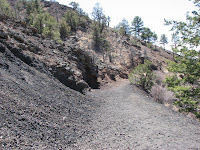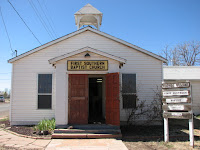An invisible creature dislodged a small lava rock high above me. First, I heard the rock hit other rocks making ever so slight of a sound that it might have gone unnoticed. I watched the small rock roll then come to rest on a slope where now it may set for an eternity. How very minimal this change to the landscape compared to what happened on this site some 10,000 years ago.
The Bandera Volcano violently erupted back then sending a flow of lava nearly 23 miles long. Imagine the sound of the blast that created the Bandera Carter measuring nearly 1,400 feet wide at the top and roughly 800 feet deep. Imagine the sight of the orange-red molten lava flying into the air then crashing down this main vent and all around. What a thunderous noise must have echoed through these New Mexico mountains when the high pressure lava began to fly and the molten rock that hardened in midair crashed back to the ground. It’s quiet at the Bandera Volcano now, ever so peaceful like a tantrum child whose made a racket and settledfor a quiet nap, for the Volcano a long nap.
Generations of the Candelaria Family have preserved the Bandera Volcano and another natural wonder - the Ice Cave. (See “When You Can’t Get to Carlsbad, Go to the Ice Cave” http://glotours.blogspot.com/2009/04/when-you-cant-go-to-carslbad-caverns-go.html ). The connection of family members dates back to the early 1900s. I met Janet Candelaria O’Connorwho has lived in the shadow of the Bandera Volcano since 1946. Janet showed me a photo of her as a red-haired teenager on a 1956 tourist brochure. It appeared in a book her father David wrote called The History of The Ice Cave. She posed for a new photo taken by me standing next to the gallery of family photos in the Old Time Trading Post.
As a tourist attraction, Janet and her family pride themselves for keeping the Bandera Volcano and Ice Cave “natural” – what Janet said “people are looking for” when they visit. She told me that over the years she has noticed that walking the trail to the Bandera Volcano can “heal the spirit and soul.” She offered the example of stressed families. Parents might be yelling at their kids before the hike to the volcano. When they return, they appear peaceful possessing a more positive attitude. Had Janet made these comments before I made my trek up Volcano Trail, I might not have believed her, but I too felt the effect of this beautiful place.
Nine observation points at numbered trail makers are explained in a self guided brochure which provides interesting details for folks making the hike up Volcano Trail. The first stop calls attention to the Lightening Tree, struck in July of 1992. Trees such as this one that grows in the old lava flow are prone to lightening strikes because of the high content of iron which attract the strike. Another stop highlights a Spatter Cone – a formation made by hot air rushing through lava and creating a type of blow hole. At one point on the trail called Volcano Land, visitors can look off into the horizon and see as many as 15 of the 29 other volcanoes in the El Malpais region. If that’s not enough to impress visitors, Devil’s Playground should. This large canyon marks the beginning of the Bandera lava tub. The lava spans out sharp and jagged as a solidified black mass across the terrain.
The best view came last. The Bandera Crater is a perfectly formed cinder cone said to be the USA’s best example of a cinder cone eruption. The massiveness dwarfed the pine trees growing from the cinders hundreds of feet below the trail lookout. The jagged lava walls of the cone looked deceivingly like rusty- brown velvet from this distance. No sounds other than a gentle wind and that one falling lava rock broke the peacefulness of this beautiful place. The Bandera Volcano emitted it own spirituality now at rest to be enjoyed by people like me who hike to see to this beautiful phenomenon.
Ice Cave Trading Co.
12000 Ice Cave Road
Grants, New Mexico 87020
1-888-ICE-CAVE
From I-40, take Exit 81 in Grants, New Mexico.
Follow Route 53 and the signs to a left turn for
Bandera Volcano on Ice Cave Road.






































